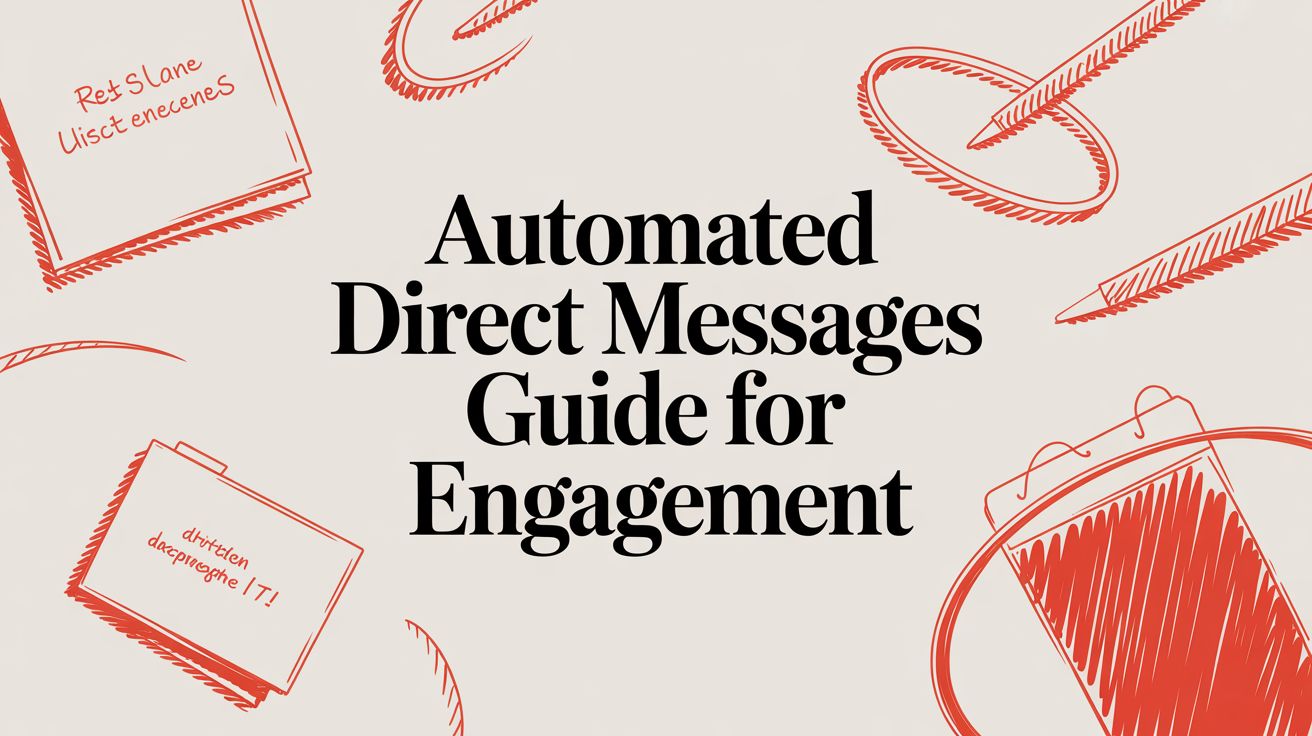Automated direct messages are basically pre-written messages that get sent out automatically when someone takes a specific action on social media. Instead of having a team member glued to the screen typing out every single welcome message or response, this technology lets you instantly connect with people at just the right moment. It’s how you start one-on-one conversations without having to do it all by hand.
The New Era of Automated Customer Connections
In a world overflowing with digital noise, it’s tough to make a real connection. Most of the time, when a brand reaches out, it feels like they’re shouting at a crowd: it’s generic, impersonal, and super easy to ignore.
Think about the difference between a random flyer left on your doorstep and a thoughtful, handwritten note that actually speaks to something you need. You’d toss the flyer, but you’d definitely read the note. That’s the idea behind using automated direct messages the right way.
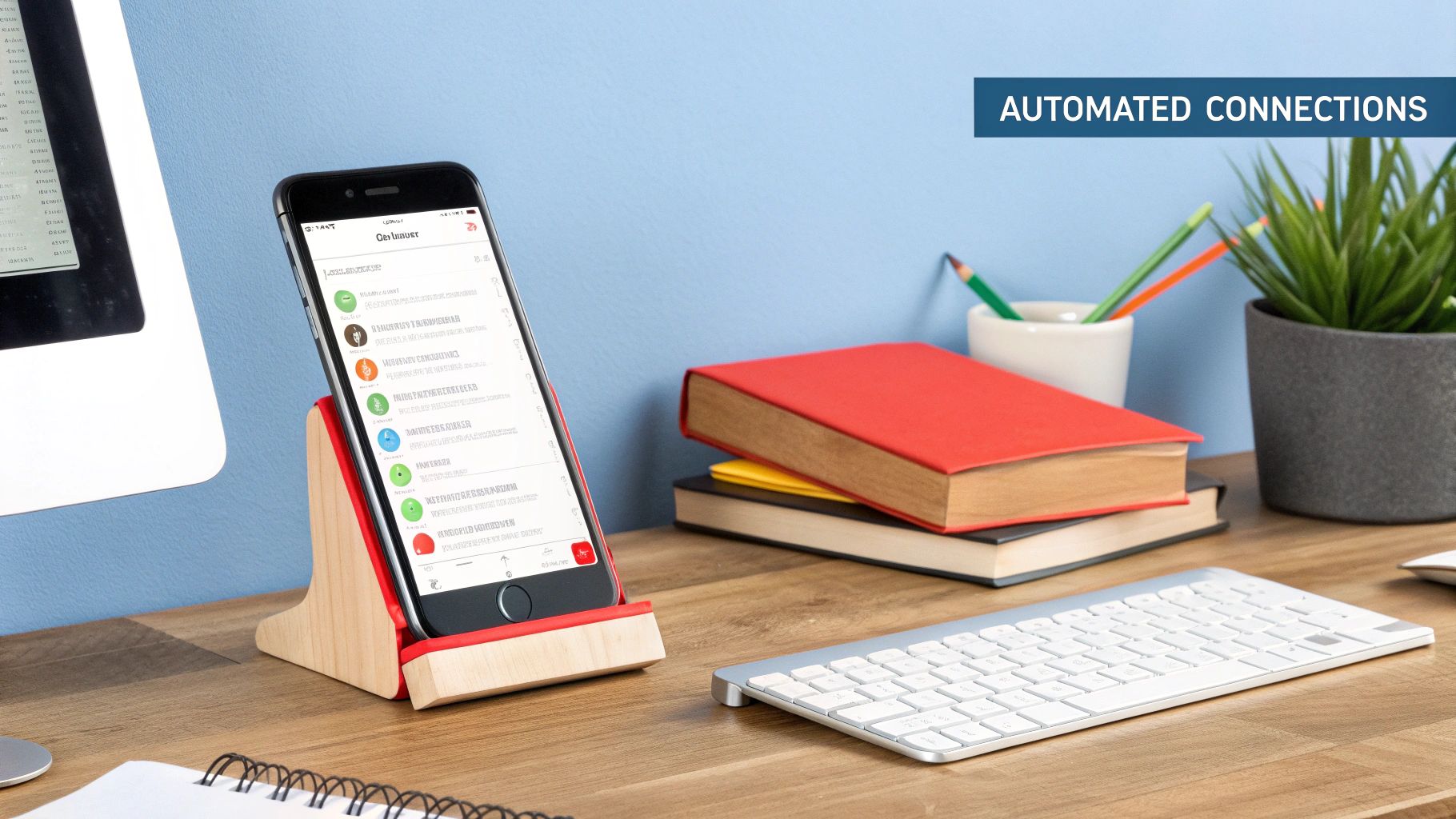
This isn’t about spamming your followers with robotic sales pitches. It’s a smart way to turn your DMs from a manual chore into a powerful tool for nurturing leads, offering immediate help, and even driving sales. It’s about meeting people where they are, with the speed and personal touch they expect, without burning out your team.
From Manual Effort to Strategic Advantage
Let’s be real: trying to manage a flood of DMs by hand is a recipe for disaster, especially as your business grows. Important questions get buried, replies take forever, and potential customers lose interest. Automation completely flips that script. It makes sure every important interaction gets a fast, relevant reply, 24/7.
Suddenly, small teams can operate with an efficiency that was once impossible. By setting up a few smart workflows, you can automatically:
- Welcome new followers with a friendly hello and point them to useful resources.
- Thank people for story mentions to make them feel seen and build a stronger community.
- Answer common questions on the spot, which frees up your support team for trickier issues.
- Qualify new leads by asking a few key questions before a sales rep even gets involved.
The point of automation isn’t to get rid of human interaction. It’s about making it better. Automation handles the repetitive, first-contact stuff, so your team can pour their energy into the meaningful conversations that build relationships and bring in revenue.
Scaling Personalized Conversations
At the end of the day, automated DMs let you have thousands of one-on-one interactions that still feel personal. By using simple things like a person’s first name and sending different messages based on what they do, you can make your DMs feel less like a mass broadcast and more like the start of a real chat.
This is what modern customer engagement is all about. For companies that want to apply this same idea to their own websites, seeing how an AI sales assistant from a platform like LeadBlaze can convert website visitors into solid leads is a perfect real-world example. The future isn’t just about automation; it’s about blending that efficiency with genuine, personal connection.
Understanding How Automated DMs Actually Work
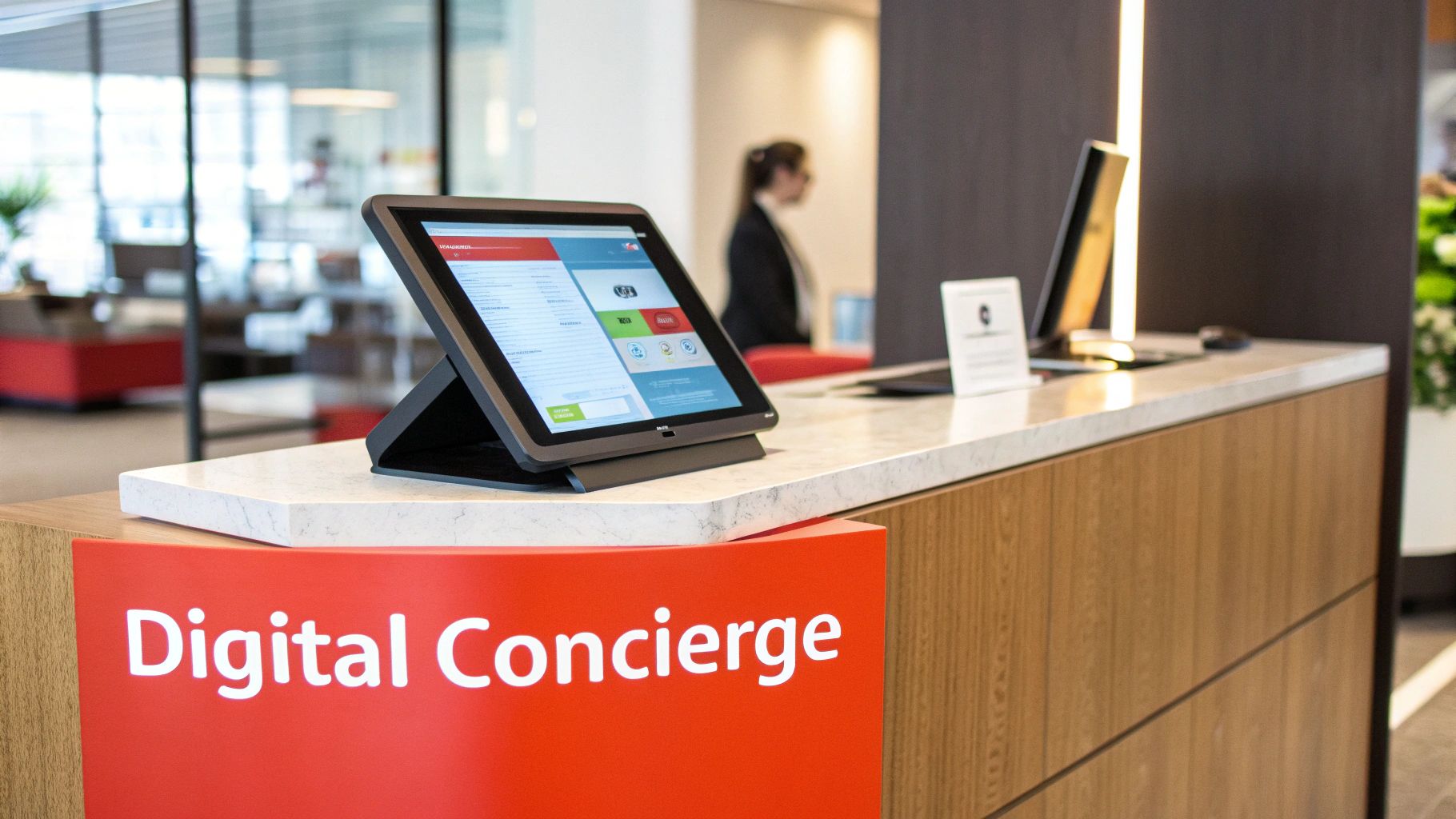
So, how does this whole automated DM thing work in the real world? It’s easy to picture a complex, robotic system, but the concept behind it is actually pretty straightforward. Think of it like setting up a digital receptionist for your social media accounts; one that’s always on duty, ready to greet new people and guide them based on a simple set of rules you create.
This digital receptionist isn’t just firing off messages into the void. It’s intelligent. It waits for a specific action to happen, and that action is what we call a trigger. This could be something as simple as a person following your account, or maybe they use a specific word in a comment on your latest post. When that trigger happens, the system springs into action and kicks off a conversation you’ve already designed.
The Building Blocks of Automation
At its core, every automated DM sequence is put together with a few key pieces. Once you get these, you’ll see how a simple action can blossom into a genuinely helpful conversation that moves your business forward.
Here’s what you’re working with:
- Triggers: This is the “if this happens” part of the setup. Common triggers are things like a new follow, a mention in a story, a specific keyword in a comment, or even a reaction to one of your posts.
- Message Sequences: This is the “then do that” response. It’s the pre-written series of messages the system sends. It can be a single, friendly “hello” or a more complex, branching chat that adapts to the user’s answers.
- Personalization Tokens: These are little magic placeholders like
{{first_name}}that automatically pull in data about the user. This one simple trick is what makes a message sent to hundreds of people feel like a personal, one-on-one chat.
Think of it like a simple “Choose Your Own Adventure” story. The trigger is the first page, and the message sequence offers different paths. The personalization tokens make the user feel like the main character.
This framework gives you a ton of flexibility. You can start small with a basic workflow, like sending a quick welcome message to every new follower. Or you can build something much more sophisticated, using AI to ask qualifying questions and route potential leads to the right person on your team.
From Simple Replies to Smart Conversations
The real power kicks in when you start connecting these building blocks. That simple “welcome” message can include buttons asking a new follower what they want to see from you. Based on their tap, they get a different follow-up message, creating a path that’s perfectly suited to their interests. It’s a game-changer.
This approach is fundamentally changing how businesses talk to their customers. Companies are using this blend of automation and personalization to bring old customers back and find new revenue streams, all by using data they already have, like someone’s purchase history. The demand is definitely there. A whopping 51% of consumers say they find SMS marketing useful, and nearly half (47%) of U.S. Millennials prefer to get updates from brands via text.
AI is the engine making this possible at scale, with 81% of businesses saying it has already made their SMS marketing better. You can dive deeper into these communication trends and statistics to see just how big the opportunity is.
Manual DMs vs Automated DMs A Quick Comparison
To really grasp the shift, it helps to put the old way of doing things side-by-side with a modern, automated strategy. The difference is night and day, especially when you look at efficiency and the overall customer experience.
Let’s break it down.
| Feature | Manual Direct Messaging | Automated Direct Messaging |
|---|---|---|
| Response Time | Slow and inconsistent; depends on staff availability. | Instant and 24/7; provides immediate answers. |
| Scalability | Extremely limited; impossible to manage at high volume. | Highly scalable; handles thousands of conversations at once. |
| Personalization | High-quality but time-consuming; difficult to apply to all. | Scalable personalization using tokens and user data. |
| Operational Cost | High labor costs; requires dedicated staff time. | Low operational cost; frees up team for high-value tasks. |
| Lead Capture | Prone to human error; leads can be missed or lost. | Consistent and reliable; captures lead data systematically. |
The table makes it obvious. While a manual, human-to-human DM will always have its place for those really deep, important conversations, automation is the only way to handle those crucial first touchpoints at scale. It builds a solid foundation for every customer relationship that follows.
Why Automating Your Direct Messages Is a Game Changer
Setting up automated direct messages isn’t just another small adjustment to your marketing plan. It’s a real shift in how you handle customer communication, and it has a massive impact on your efficiency, customer happiness, and, ultimately, your bottom line. By letting technology handle the initial, repetitive conversations, you open up some serious growth potential.
This entire approach stands on three key ideas: becoming incredibly efficient, giving every customer a consistently great experience, and directly turning more leads into sales. Each one of these pillars supports the next, creating a powerful system for growth that can scale with your business.
Achieve Radical Efficiency
Think about your team’s day-to-day grind for a second. How much of their time is eaten up by answering the same five questions over and over? Or welcoming every single new follower? Or manually sending people the right link? That’s valuable time they could be spending on solving tricky customer problems or building real relationships with high-value leads.
Automated DMs act like a smart receptionist, handling all those routine tasks instantly and without errors. This frees your team from the boring, repetitive work and lets them apply their skills where they’re needed most, in the kind of conversations that really need a human touch. The result? A more productive and motivated team, and a much more efficient operation overall.
Deliver an Exceptional Customer Experience
In the world we live in now, speed is everything. People expect answers right away, 24/7. That’s a standard that’s almost impossible for a purely human team to keep up with. This is where automation really shines, by providing immediate, helpful responses anytime, day or night.
When a potential customer messages you at 10 PM on a Tuesday, they don’t want to wait until the next morning for a reply. An automated system can give them an instant answer, send them a link to your FAQ page, or simply let them know a real person will follow up during business hours. Just that immediate acknowledgment makes people feel seen and valued, which completely changes their first impression of your brand for the better.
An automated response is always better than no response. It shows you’re attentive and respects your customer’s time, setting a positive tone for the entire relationship from the very first interaction.
This infographic does a great job of showing how these benefits flow into one another, starting with simple task automation and leading to real business results.
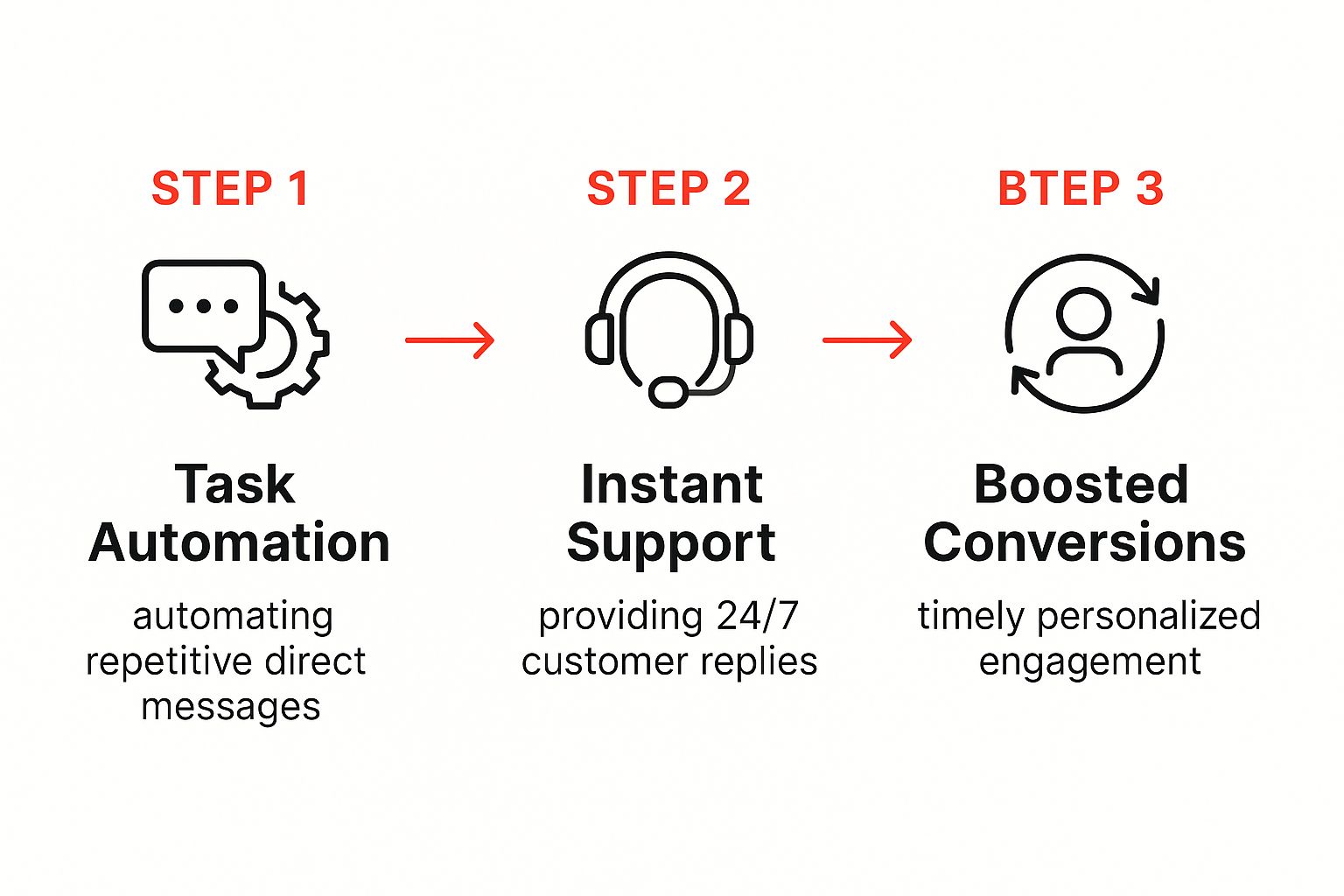
As you can see, there’s a clear line connecting smarter operations with more money in the bank. Automating tasks directly leads to better sales outcomes.
Boost Conversions and Drive Sales
At the end of the day, efficiency and a great customer experience are all about one thing: growth. Automated direct messages are a fantastic tool for turning casual interest into qualified leads and actual sales. By engaging with people the moment they show interest, you keep them moving through your sales funnel instead of letting them get distracted and wander off.
For example, you can set up an automation that kicks in when someone comments with a specific keyword on one of your Instagram posts. The system can instantly slide into their DMs with a discount code or a direct link to the product they’re curious about. It’s a seamless process that removes any friction and strikes while the iron is hot.
This isn’t just theory; this strategy gets results. One e-commerce case study showed that automating Instagram DMs led to a 25% increase in click-through rates and a 15% boost in direct sales. All of that happened while they cut their customer service response times by 30%. By turning passive engagement into an active sales channel, you create new revenue streams that work for you around the clock. You can learn more about how brands are using these powerful auto DM platforms to get similar results.
How to Launch Your First Automated DM Campaign
Diving into automated direct messages can seem a bit daunting at first, but it’s really just a series of straightforward steps. Think of this as your practical roadmap for getting started, one that doesn’t require you to be a tech genius. By breaking it all down, you can launch a campaign that’s both powerful and genuinely human.
The whole process can be boiled down to five clear stages. Each one builds on the last, guiding you from a rough idea to a fully functioning automation that actually connects with your audience.
Step 1: Define Your Primary Goal
Before you even think about writing a message, you need to be crystal clear on what you want to achieve. An automation without a goal is like a ship without a rudder, it’s moving, but who knows where it’s going. This one objective will guide every decision you make, from the trigger you pick to the words you use.
Ask yourself: What’s the single most important thing I want this campaign to do?
- Lead Generation: Is your main aim to find potential customers and get their contact info?
- Customer Support: Are you trying to instantly answer common questions to free up your support team?
- Sales and Conversions: Is the goal to push traffic to a product page or share a discount code to make more sales?
Sticking to one primary goal keeps your campaign laser-focused and makes it so much easier to measure what’s working later on.
Step 2: Choose Your Platform and Triggers
With your goal set, it’s time to pick your tools and decide what specific action will kick off your automation. The platform you choose, like LeadBlaze for your website or another tool for social media, will dictate the kinds of triggers you have at your disposal.
A trigger is simply the event that tells your system, “It’s go time!” For instance, a classic trigger for a welcome message is a new follower on Instagram. For a sales-focused campaign, the trigger might be a user commenting with a keyword like “DEAL” on one of your posts.
Step 3: Map Your Conversational Workflow
Now for the fun part: sketching out the conversation. You don’t need fancy software for this; a simple flowchart on a piece of paper or a whiteboard is perfect. This map is your blueprint for the entire automated chat.
Start with the trigger, then draw out the sequence of messages. Crucially, think about how people might respond. If you ask a question with “Yes” or “No” options, for example, what happens next for each choice? A visual guide like this helps you spot dead ends and ensure the conversation flows smoothly.
This is where a tool like LeadBlaze comes in handy, giving you a clean dashboard to manage these conversations once they’re up and running.
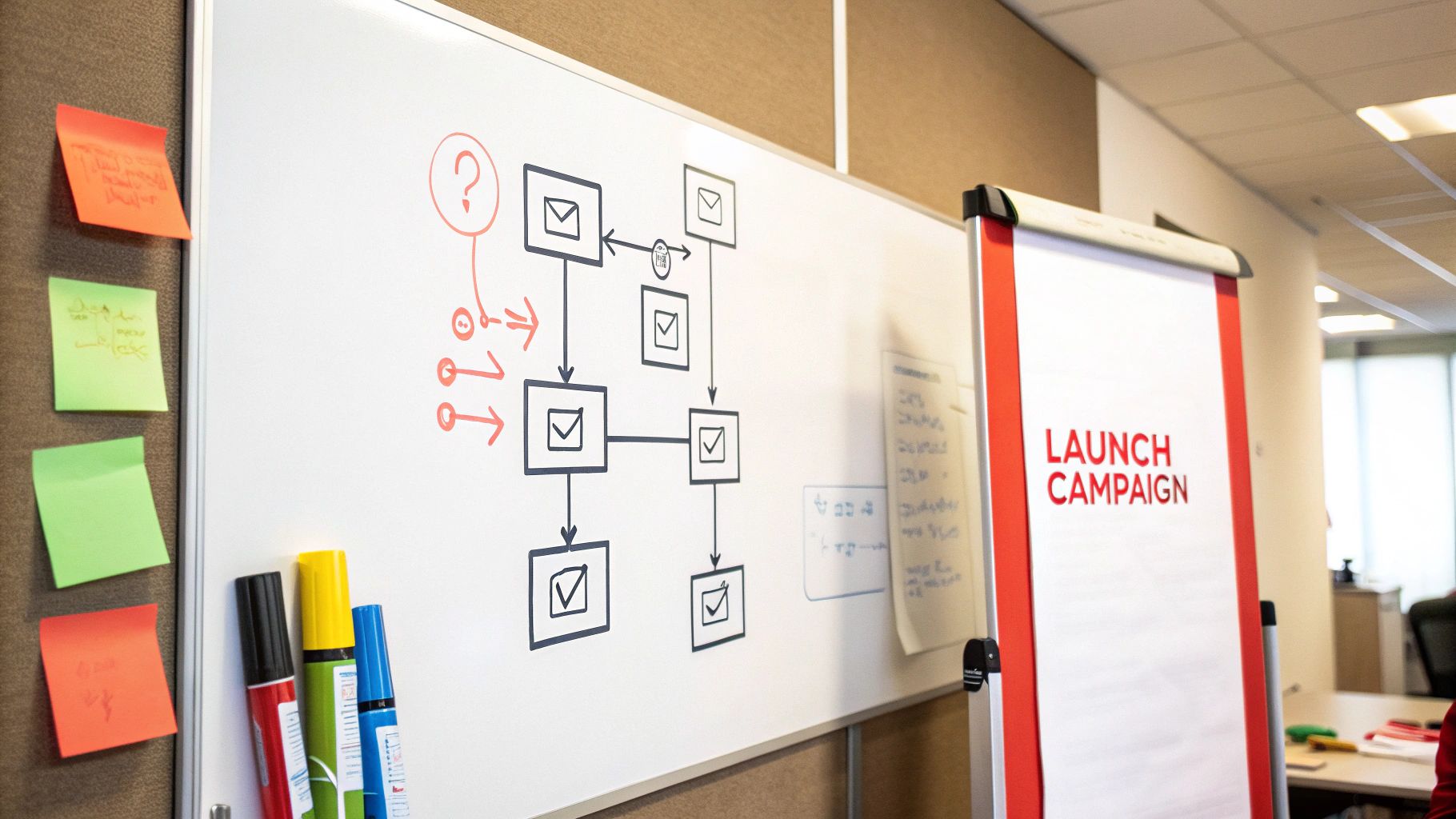
Having a clear interface is vital for keeping track of all the moving parts and seeing how your campaigns are performing at a glance.
Step 4: Write Compelling and Personalized Messages
This is where the magic really happens. Your messages have to sound like they came from a real person, not a robot. Write in a conversational tone that fits your brand’s personality. Keep your sentences short, sprinkle in emojis where it feels right, and always focus on providing value.
The most important trick? Use personalization tokens. Just adding something as simple as {{first_name}} instantly makes the message feel less like a mass email blast and more like a one-on-one chat.
Pro Tip: Always, always include a clear call-to-action (CTA). Tell the user exactly what you want them to do next, whether it’s clicking a link, answering a question, or watching a video. Don’t leave them hanging.
Step 5: Test, Launch, and Analyze
Whatever you do, don’t launch a campaign blind. Run through the entire flow yourself or have a teammate do it to catch any typos, broken links, or weird gaps in the conversation. Once you’re sure it’s running smoothly, you’re ready to go live.
But your job isn’t done. After launching, keep a close eye on your analytics. Track key metrics like open rates, click-through rates, and reply rates. This data is gold, it tells you what’s working and what’s not, so you can tweak your messages and improve your results over time. A great way to begin is by using a platform that makes this easy; you can sign up for LeadBlaze and get your first website-based campaign running in just a few minutes.
Making Automated Engagement Feel Genuinely Human
The real magic of automated DMs isn’t just speed; it’s about making people feel seen and valued, even when you’re reaching them by the thousands. But let’s be honest, there’s a razor-thin line between a helpful automated message and an annoying spam bot. Get it wrong, and you risk damaging your brand’s reputation. Nailing the best practices is everything if you want to build trust, not burn it.
The whole point is to use automation to amplify human connection, not replace it. Every single automated touchpoint has to be crafted with real authenticity and a deep respect for the person on the other end.
Go Beyond a First Name with Hyper-Personalization
Just dropping in a first name isn’t enough anymore. Real personalization digs deeper, using data and context to send a message that feels like it was written just for them.
Instead of a one-size-fits-all welcome, think about segmenting your audience. A message for someone who followed you from a specific ad campaign should be completely different from one for someone who found you organically. That small detail shows you’re actually paying attention.
Here are a few ways to add those crucial layers of personalization:
- Segment by Source: Greet people differently based on where they came from. Did they comment on a specific post? Reply to a story? Click a link on your website? Each path deserves a unique welcome.
- Reference Past Interactions: If your tools can do it, mentioning a past purchase or a previous conversation adds powerful context and makes the interaction feel like a continuing dialogue.
- Create Time-Sensitive Offers: Send a message that connects to what’s happening right now, like a limited-time offer related to a post they just engaged with.
Set Clear Expectations from the Start
When it comes to automation, honesty really is the best policy. Most people are perfectly fine interacting with a bot, as long as they know that’s what’s happening. The moment you try to trick someone into thinking they’re talking to a person, you’ve lost their trust for good.
A simple, upfront opener works wonders. Something like, “Hey {{first_name}}! Thanks for getting in touch. I’m the automated assistant for [Your Brand Name],” sets the stage perfectly. It’s transparent, manages expectations, and kicks things off with a helpful vibe.
This kind of transparency immediately builds credibility and makes people more comfortable following the path you’ve laid out for them.
Always Provide an Escape Hatch to a Real Person
No matter how smart your automation is, some problems just need a human touch. The last thing you want is a frustrated customer stuck in an endless bot loop, it’s a brand’s worst nightmare. You absolutely must provide a clear, easy way for users to connect with a real person.
A simple button or a keyword like “talk to a human” or “help” should be available at every step of the conversation. This “escape hatch” ensures that complex or sensitive issues get routed to your team, which shows your customers you’re truly there to support them.
Continuously Analyze, Tweak, and Improve
Your first automated DM campaign will not be your best one. The secret to long-term success is treating your automations like living, breathing projects that need constant attention. You have to dive into your analytics to see what’s hitting the mark and what’s falling flat.
This is more important than ever. Think about it: 80% of businesses are now using software to automate their SMS campaigns. They’re reaching a global audience where an unbelievable 98% of messages are opened. To cut through that noise, you have to be smarter and more refined than everyone else. If you want to grasp the sheer scale of this, check out these incredible SMS marketing and its statistics to see the competitive landscape you’re in.
The Future of Personalized Communication
If you take one thing away from this guide, let it be this: automated direct messages are no longer just a “nice-to-have” tool. They’re a core part of scaling your business, making your team more efficient, and actually seeing those growth numbers climb. The real secret, though, isn’t just turning on a bot; it’s using automation to deliver genuine value, not just spam.
This whole journey isn’t about replacing people with robots. It’s about letting automation handle the repetitive stuff, the initial hellos, the frequently asked questions, the basic lead sorting, so your team can jump in where it matters most. That’s where the real relationships are built.
The Next Wave of AI in Conversation
Looking forward, AI is getting so much smarter, and it’s going to make these automated chats feel incredibly human. Think beyond rigid scripts. We’re talking about AI that can actually grasp what a person means, how they feel, and what they’ve talked about before. The shift is from simply reacting to a query to proactively being helpful.
Here’s what’s coming down the pike for automated direct messages:
- Deeper Personalization: AI will soon be able to look at what a user is doing on your site in real-time and adjust the conversation on the fly to be hyper-relevant.
- Predictive Engagement: Imagine systems that can guess what a customer needs and start a helpful chat before they even think to ask for help.
- Seamless Human Handoffs: The AI will know exactly when a conversation is getting too complex and needs a human touch, smoothly passing it over to the right person with all the context they need.
The ultimate goal is to erase the line between “automated” and “personal.” The tech will become so good that people won’t even think they’re talking to a machine, they’ll just feel heard and helped.
Your First Step into Automation
The message here is that you can do this. You don’t need a huge team of engineers or a massive budget to get started. The trick is to begin with a small, manageable campaign, see what works, and build from there. Start thinking of automation as a fundamental part of how you grow your business.
Every single conversation you automate is one more step toward a business that’s more responsive, more efficient, and ready to scale.
Ready to see how you can turn your website visitors into qualified leads, even while you sleep? Take the first step on your automation journey and see how an AI sales assistant from LeadBlaze can start conversations that actually convert.
Still Have Questions About Automated DMs?
Getting started with automated DMs can feel a bit daunting. You’re probably wondering about the setup, the cost, and most importantly, how your followers will react. Let’s tackle some of the most common questions head-on.
Will I Sound Like a Canned Robot?
That’s a fair question, and honestly, a big fear for anyone who cares about their brand.
The good news is you have complete control over this.
The trick is to inject your brand’s personality into every message. Use personalization features, like their first name, to make it feel like a one-on-one chat. And always, always make it clear how they can talk to a real person if they need to. Think of automation as the friendly greeting at the door, not the entire conversation.
Is This Going to Be a Technical Nightmare to Set Up?
Not anymore. Tools today are built for marketers and business owners, not developers. You can literally get your first automated welcome message live in a few minutes.
Just pick a trigger (like “new follower”), write a quick, helpful message, and you’re good to go. You don’t need to build a complex, multi-step chatbot from the get-go.
The best approach is to start simple. Solve one small problem first, like welcoming new followers or instantly answering your most common FAQ. Once you see how it works and get comfortable, you can build from there.
But Do People Actually Like Getting Automated Messages?
When they’re helpful and timely? Absolutely. People value speed. An instant answer to their question is a much better experience than waiting hours for someone to get back to them.
As long as you’re upfront about it being an automated message and you’re providing genuine value, your audience will appreciate it. The proof is in the numbers: 80% of businesses are now using automation for SMS campaigns because it meets a very real customer demand for immediate engagement.
Ready to turn your website visitors into qualified leads 24/7? LeadBlaze can help you start valuable conversations instantly. Get started with your free trial at https://leadblaze.ai.
